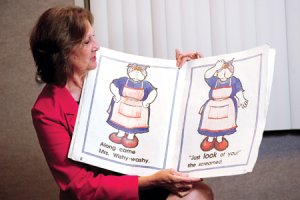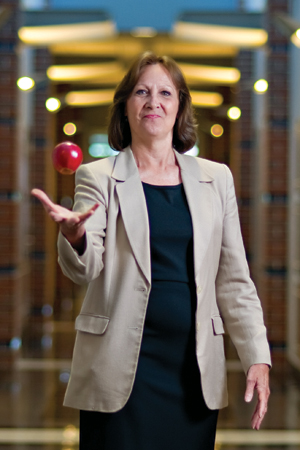Heads bent together over the thin, colorful book, a boy and his clinician read. He fidgets, bobbing a leg or hiding inside the T-shirt he keeps pulling over his close-cropped blond head.
“Why do you think he’s on his tippy toes?” asks the clinician, pointing to the page where Little Hamster is trying to mow the lawn for his mother. And then, when she has the boy’s attention again, they turn the page. Little Hamster is setting the table. “What do you think will happen next?”
The clinician, a graduate student, is working with the Kearney area third grader in the UNK Speech, Language and Hearing Clinic. From her office in the same building, Dr. Linda Crowe watches the session and nods, pleased.
“That’s what good readers do, anticipate the story,” she said, explaining the communicative reading strategies (CRS) her student is using to help the boy understand not just the words on the page, but how they come together to make meaning.
It is a philosophy Crowe advocates in the classroom, in the clinic, and through her current research that shows such strategies could help children overcome literacy problems more quickly.
Crowe, chair and professor in the Department of Communications Disorders, has published numerous journal articles on issues related to literacy. In 2006, her research into the language development of preschoolers was featured in news articles in the “Wall Street Journal,” “The Miami Herald,” “The New Atlantis Journal” and other publications.
Many of her most recent publications were co-authored with students, including 2008 articles titled “Traditional Versus Electronic Storybooks During Adult-Toddler Interactions” and “Gender Differences in Preschool Children’s Language and Movement.” Both appeared in the Undergraduate Research Journal for the Human Sciences, and the former earned co-author Rachel Barnett, now a graduate student at the University of Nebraska-Lincoln, an award from the journal and a $3,000 scholarship.
Recent national presentations have focused on Crowe’s findings about language development, the use of storybooks, and the connection between movement and language in toddlers. Crowe said her work is all connected to her primary interest, which is literacy.
“My passion, and what I enjoy the most, is literacy,” she said, adding that the recent national emphasis on improving education dovetails well with her current research on communicative research strategies.
“(Educators have) started trying to find the ‘magic key’ to literacy,” she said, and want to know what effect different interventions have on students who are struggling. What she has found is that by using communicative reading strategies, educators may be able to more quickly identify what kind of help children need as they are learning to read.
The current trend in education, she said, is to use a system called Responsiveness-to-Intervention to identify and address learning problems early in a child’s academic career, especially in reading. What this means is that students receive interventions delivered in the classroom for several weeks, and then they are screened to assess progress in reading. Those who are not progressing quickly enough are given a higher level of assistance, and the process repeats for several more weeks. Those who still do not progress, who are “resistant to the intervention,” are then referred for comprehensive evaluations and further assistance.
 “Some of the research I’ve been doing suggests we can identify early those who would be resistors to those interventions using communicative reading strategies,” Crowe said. That would mean students who need the most help could get it more quickly, without waiting weeks or months for screening assessment of intervention effectiveness.
“Some of the research I’ve been doing suggests we can identify early those who would be resistors to those interventions using communicative reading strategies,” Crowe said. That would mean students who need the most help could get it more quickly, without waiting weeks or months for screening assessment of intervention effectiveness.
In a recent presentation at the annual conference of the American Speech, Language and Hearing Association, Crowe presented findings from a study of 16 school-age children, all of whom were struggling readers. They were assigned to two different interventions – Group 1 used communicative reading strategies, and Group 2 used a more typical skill-based reading approach.
Students went through initial sessions with clinicians giving them different kinds of prompts to help them as they read. These sessions were meant to judge their beginning skill level in decoding words and reading comprehension. After 15 one-hour sessions of reading intervention, clinicians measured their progress.
The key finding, Crowe said, was how accurately progress could be predicted for the Group 1 students. At their initial testing, clinicians used communicative reading strategies, noted any immediate changes in decoding and comprehension, and used those as a basis for predicting how the students would respond to the sessions. Clinicians accurately predicted the decoding change in five of the eight Group 1 students and comprehension change in seven of the eight students.
The findings need further and larger studies, Crowe said, but they are an indicator of how effective communicative reading strategies can be.
Crowe said she became interested in communicative reading through Dr. Janet Norris, who was her mentor while she was earning her master’s degree in speech-language pathology at the University of Nebraska-Lincoln. Crowe followed Norris to Louisiana State University, where she earned her doctorate in communication sciences disorders in 1996.
Crowe came to academia after teaching in elementary schools, including stints at two rural Nebraska schools. At one, she taught kindergarten through eighth grade. She said the experience made her realize how much some students struggle. The experience led her back to school for more training.
“There were a couple of kids in the secondary that needed intervention I couldn’t give,” she said. Her training in speech pathology, then, taught her how valuable a strong diagnostic session with a child can be. That is a lesson she puts to use now with the adult and school-age clients who come to the UNK Speech, Language and Hearing Clinic. The clinic is in high demand from clients with all kinds of communication disorders, including those struggling with literacy. Crowe does initial sessions with clients, then observes sessions between clients and clinicians.
The key element in using a communicative reading strategies approach is that it addresses all parts of reading at once, Crowe said, adding that rather than a single activity, reading is actually a set of skills. Readers have to think about the phonology of language, the syntax, the morphology, the semantics and the pragmatics.
“Some kids can do certain pieces, such as phonology, so they focus only on sounding out words but ignore meaning, and sometimes you get kids who can understand it, but they can’t decode for anything,” she said. “My philosophy is that reading is pulling all those pieces together.”
Teachers can help students make those connections using communicative reading strategies as the clinician did for her third-grade client. Their sessions, made up of three parts, began with a first read of the day’s material with verbal prompts intended to help him relate to the situations he was seeing on the page. A second time through, she offered fewer comments but responded to the boy’s questions in ways designed to help him connect the story to something meaningful.
“Are they going to have dinner?” the boy asked, as he read about Little Hamster trying to set the table for his mom.
“Dinner, or supper? Which do you have at your house?” the student clinician replied.
Later, when the boy was stuck on a word, she did not ask him to sound it out phonetically but, instead, to make a judgment about what the word had to be, based on the meaning of the sentence.
“So his stomach is speaking. He’s really, really . . .”
“Hungry.”
Later, the boy wrote about what he had read, and finally, they did an activity that used an element from the book. In this case, they prepared an apples-and-peanut-butter snack for each other, the way Little Hamster had tried to make food for his mother.
Throughout the session, Crowe explained, her student had been focused on building the boy’s understanding, not just on what sounds the words made, or what they meant, but on how they were being used to tell a story and convey ideas.
“He needs to see how words connect meaning,” she said, and so far the sessions have been fruitful. Referred by an area school, the boy started the semester with pre-primary reading skills. At the end, he was reading second- and third-grade texts, with some assistance.
